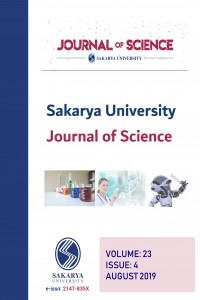Abstract
This study compares two reversible image
watermarking algorithms applied to a digital image. The first algorithm is a
method based on adaptive watermarking of prediction-errors. With this method,
as in the existing reversible image watermarking methods, pixels are embedded
in two different ways according to the values of prediction-errors instead of
applying the same watermarking algorithm to all pixels in the imageAccordingly,
the image pixels are divided into two blocks as uniform and non-uniform. The
watermarking capacity has been increased by embedding 2-bit to specific pixels
of uniform blocks and 1-bit to specific pixels of non-uniform blocks. The
second algorithm is a method based on interpolation errors. In this method,
interpolation error is utilized. The two methods compared with each other were
compared with the existing methods in the literature by using computer
simulations, and superior and weak aspects of the methods were determined.
Keywords
reversible watermarking adaptive reversible image watermarking pixel selection prediction-error expansion interpolation error expansion
References
- J. M. Barton, “Method and Apparatus for Embedding Authentication Information Within Digital Data,” U.S. Patent 5 646 997, 1997.
- C. I. Podilchuk, E. J. Delp, “Digital Watermarking: Algorithms and Applications,” July, pp. 33–46, 2001.
- B. Furht, E. Muharemagic, D. Socek, “Multimedia Encryption and Watermarking. Springer. ”
- D. M. Thodi and J. J. Rodriguez, “Expansion embedding techniques for reversible watermarking,” IEEE Trans. Image Process., vol. 16, no. 3, pp. 721–730, Mar. 2007.
- W. Hong, T. S. Chen, and C. W. Shiu, “Reversible data hiding for high quality images using modification of prediction errors,” J. Syst. Softw., vol. 82, no. 11, pp. 1833–1842, Nov. 2009.
- Z. Ni, Y. Q. Shi, N. Ansari, and W. Su, “Reversible data hiding,” IEEE Trans. Circuits Syst. Video Technol., vol. 16, no. 3, pp. 354–362, Mar. 2006.
- S. K. Lee, Y. H. Suh, and Y. S. Ho, “Reversible image authentication based on watermarking,” in Proc. IEEE ICME, 2006, pp. 1321–1324.
- J. Tian, “Reversible data embedding using a difference expansion,” IEEE Trans. Circuits Syst. Video Technol., vol. 13, no. 8, pp. 890–896, Aug. 2003.
- M. Fallahpour, “Reversible image data hiding based on gradient adjusted prediction,” IEICE Electron. Express, vol. 5, no. 20, pp. 870–876, Oct. 2008.
- L. Luo, Z. Chen, M. Chen, X. Zeng, and Z. Xiong, “Reversible image watermarking using interpolation technique,” IEEE Trans. Inf. Forensics Security, vol. 5, no. 1, pp. 187–193, Mar. 2010.
- L. Zhang and X. Wu, “An edge-guided image interpolation algorithm via directional filtering and data fusion,” IEEE Trans. Image Process., vol. 15, no. 8, pp. 2226–2238, Aug. 2006.
- M. J. Weinberger, G. Seroussi, G. Sapiro, “The LOCO-I Lossless Image Compression Algorithm: Principles and Standardization into JPEG-LS,” IEEE Trans. image Process., vol. 9, no. 8, pp. 1309–1324, 2000.
- X. Li, B. Yang, T. Zeng, “Efficient reversible watermarking based on adaptive prediction-error expansion and pixel selection,” IEEE Trans. Image Process., vol. 20, no. 12, pp. 3524–33, Dec. 2011.
Abstract
References
- J. M. Barton, “Method and Apparatus for Embedding Authentication Information Within Digital Data,” U.S. Patent 5 646 997, 1997.
- C. I. Podilchuk, E. J. Delp, “Digital Watermarking: Algorithms and Applications,” July, pp. 33–46, 2001.
- B. Furht, E. Muharemagic, D. Socek, “Multimedia Encryption and Watermarking. Springer. ”
- D. M. Thodi and J. J. Rodriguez, “Expansion embedding techniques for reversible watermarking,” IEEE Trans. Image Process., vol. 16, no. 3, pp. 721–730, Mar. 2007.
- W. Hong, T. S. Chen, and C. W. Shiu, “Reversible data hiding for high quality images using modification of prediction errors,” J. Syst. Softw., vol. 82, no. 11, pp. 1833–1842, Nov. 2009.
- Z. Ni, Y. Q. Shi, N. Ansari, and W. Su, “Reversible data hiding,” IEEE Trans. Circuits Syst. Video Technol., vol. 16, no. 3, pp. 354–362, Mar. 2006.
- S. K. Lee, Y. H. Suh, and Y. S. Ho, “Reversible image authentication based on watermarking,” in Proc. IEEE ICME, 2006, pp. 1321–1324.
- J. Tian, “Reversible data embedding using a difference expansion,” IEEE Trans. Circuits Syst. Video Technol., vol. 13, no. 8, pp. 890–896, Aug. 2003.
- M. Fallahpour, “Reversible image data hiding based on gradient adjusted prediction,” IEICE Electron. Express, vol. 5, no. 20, pp. 870–876, Oct. 2008.
- L. Luo, Z. Chen, M. Chen, X. Zeng, and Z. Xiong, “Reversible image watermarking using interpolation technique,” IEEE Trans. Inf. Forensics Security, vol. 5, no. 1, pp. 187–193, Mar. 2010.
- L. Zhang and X. Wu, “An edge-guided image interpolation algorithm via directional filtering and data fusion,” IEEE Trans. Image Process., vol. 15, no. 8, pp. 2226–2238, Aug. 2006.
- M. J. Weinberger, G. Seroussi, G. Sapiro, “The LOCO-I Lossless Image Compression Algorithm: Principles and Standardization into JPEG-LS,” IEEE Trans. image Process., vol. 9, no. 8, pp. 1309–1324, 2000.
- X. Li, B. Yang, T. Zeng, “Efficient reversible watermarking based on adaptive prediction-error expansion and pixel selection,” IEEE Trans. Image Process., vol. 20, no. 12, pp. 3524–33, Dec. 2011.
Details
| Primary Language | English |
|---|---|
| Subjects | Electrical Engineering |
| Journal Section | Research Articles |
| Authors | |
| Publication Date | August 1, 2019 |
| Submission Date | October 2, 2018 |
| Acceptance Date | February 1, 2019 |
| Published in Issue | Year 2019 Volume: 23 Issue: 4 |
Cite
INDEXING & ABSTRACTING & ARCHIVING
Bu eser Creative Commons Atıf-Ticari Olmayan 4.0 Uluslararası Lisans kapsamında lisanslanmıştır .


